The First Mile Logistics Delivery Software Market is estimated to be valued at USD 4.4 billion in 2025 and is projected to reach USD 9.2 billion by 2035, registering a compound annual growth rate (CAGR) of 7.6% over the forecast period. Growth in the early phase, from 2025 to 2029, remains steady, expanding from USD 5.1 billion to USD 5.9 billion as adoption spreads across retail and e-commerce logistics.
By 2030, values touch USD 6.8 billion, where the YoY growth rate reaches its near-peak before slightly moderating. From 2031 to 2035, momentum continues with increments of USD 0.5–0.7 billion per year, reaching USD 9.2 billion by 2035. The YoY growth curve demonstrates a gradual stabilization, reflecting a shift from penetration to optimization. The pattern suggests that while early years are driven by digitization demand, the later phase is shaped by advanced integration of AI-enabled route planning and predictive logistics capabilities.
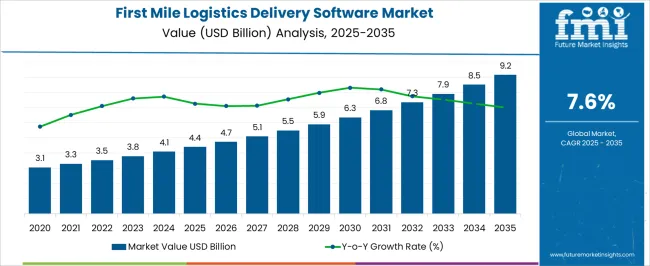
| Metric | Value |
|---|---|
| First Mile Logistics Delivery Software Market Estimated Value in (2025 E) | USD 4.4 billion |
| First Mile Logistics Delivery Software Market Forecast Value in (2035 F) | USD 9.2 billion |
| Forecast CAGR (2025 to 2035) | 7.6% |
The first mile logistics delivery software market is experiencing rapid growth driven by the increasing need for efficient supply chain management and last-mile connectivity improvements. As companies focus on optimizing their delivery operations from origin to distribution centers, software solutions that enhance route planning and fleet management have gained prominence.
Growing e-commerce penetration and consumer demand for faster deliveries have encouraged businesses to adopt sophisticated logistics software to reduce costs and improve accuracy. Advancements in cloud computing have enabled scalable and flexible deployment of delivery software, allowing real-time data access and collaboration across stakeholders.
Regulatory pressures to lower carbon emissions and improve delivery sustainability are also influencing technology adoption. Looking ahead, the market is expected to expand due to ongoing digital transformation initiatives and the integration of AI-driven analytics for smarter logistics management. Software components are leading segmental growth, applications focused on route planning and optimization, and cloud-based deployment models, reflecting their importance in modern logistics ecosystems.
The first mile logistics delivery software market is segmented by component, application, deployment type, organization size, end-user industry, and geographic regions. By component, the first mile logistics delivery software market is divided into Software and Service. In terms of application, the first mile logistics delivery software market is classified into Route planning and optimization, Inventory management, Order management, Shipment tracking, and Others. Based on the deployment type, the first mile logistics delivery software market is segmented into Cloud-based and On-premises. By organization size, the first-mile logistics delivery software market is segmented into large enterprises and Small and medium-sized enterprises (SMEs). By end-user industry, the first mile logistics delivery software market is segmented into Retail and E-Commerce, Manufacturing, Healthcare, Automotive, Food and beverage, Energy and utilities, Aerospace and defense, and Others. Regionally, the first-mile logistics delivery software industry is classified into North America, Latin America, Western Europe, Eastern Europe, Balkan & Baltic Countries, Russia & Belarus, Central Asia, East Asia, South Asia & Pacific, and the Middle East & Africa.
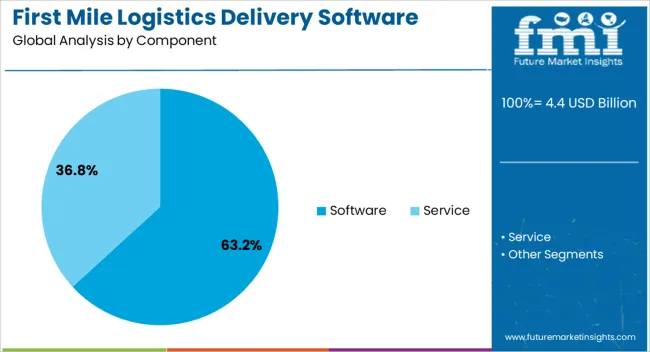
The Software segment is projected to hold 63.2% of the first mile logistics delivery software market revenue in 2025, retaining its leadership position among components. This segment’s growth is driven by the rising demand for integrated platforms that provide comprehensive visibility and control over first mile operations.
Software solutions have become essential for automating order management, scheduling pickups, and managing inventory flows efficiently. Continuous enhancements in user interface design, analytics capabilities, and integration with third-party systems have further strengthened the software segment.
Additionally, businesses are increasingly prioritizing scalable solutions that can adapt to fluctuating demand and geographic expansion. The software component's ability to support multiple logistics functions in a unified platform ensures its continued dominance.
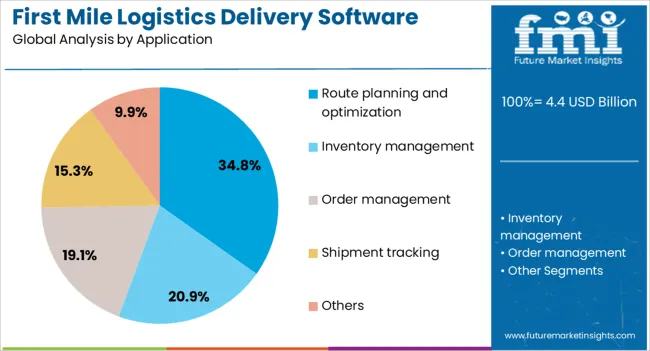
The Route Planning and Optimization segment is expected to account for 34.8% of the market revenue in 2025, establishing itself as a critical application area. This segment’s growth has been fueled by the need to improve delivery efficiency, reduce fuel consumption, and minimize transit times.
Logistics operators have adopted advanced route planning tools that use real-time traffic data and predictive analytics to dynamically adjust delivery routes. This has resulted in cost savings and improved customer satisfaction by ensuring timely deliveries.
The growing complexity of supply chains and increasing volume of small shipments have further emphasized the importance of effective route optimization. With ongoing advancements in machine learning and geospatial technologies, the route planning application is anticipated to maintain its key role in driving market growth.
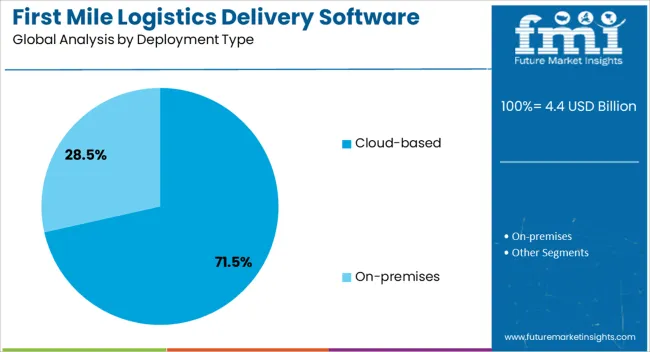
The Cloud-based deployment segment is projected to contribute 71.5% of the first mile logistics delivery software market revenue in 2025, solidifying its position as the dominant deployment model. The rapid adoption of cloud computing has been driven by its ability to provide scalable, accessible, and cost-effective solutions that enable real-time collaboration among stakeholders.
Cloud platforms enable logistics companies to rapidly implement software updates, enhance security measures, and provide seamless mobile access across a wide range of devices. The flexibility offered by cloud-based solutions supports the dynamic nature of first mile logistics operations, accommodating changes in shipment volumes and routes.
Furthermore, the cloud facilitates integration with other supply chain technologies such as warehouse management and transportation management systems. As digital transformation accelerates across the logistics sector, cloud-based deployment is expected to remain the preferred choice for software solutions.
First mile logistics delivery software is being driven by e-commerce, automation, and logistics investments. Its role has shifted from support tool to a central enabler of supply chain competitiveness.
Adoption of first mile logistics delivery software has been increasing as businesses prioritize digital integration in supply chain management. The growing penetration of e-commerce has placed heavy emphasis on upstream delivery operations, where software provides visibility, reduces delays, and ensures accurate load planning. Companies are using these platforms to manage supplier-to-warehouse transfers more effectively, reducing inefficiencies in scheduling and resource allocation. Retailers, manufacturers, and third-party logistics providers have adopted such tools to streamline communication between stakeholders and minimize errors linked to manual handling. This transformation is strongly supported by expanding cross-border trade and the demand for multi-modal transport management, placing first mile software as an essential enabler of operational excellence in logistics chains.
First mile delivery solutions are evolving with greater integration of data-driven tools that enhance predictive accuracy and decision-making. Software platforms are embedding artificial intelligence and machine learning algorithms to forecast demand patterns, optimize dispatch, and predict traffic congestion. This has helped organizations cut costs while improving delivery reliability. Automation of scheduling, route planning, and vehicle capacity utilization has elevated productivity levels across supply networks. Companies are also deploying integrated dashboards that allow real-time monitoring of supplier pickups and shipment consolidation. By embedding automation into the first mile, logistics operators are reducing human errors, accelerating order cycles, and improving customer satisfaction. These benefits illustrate why data-centric automation has become a central driver of market momentum.
E-commerce growth continues to be a major catalyst influencing the adoption of first mile logistics delivery software. Online retailers rely on these platforms to handle bulk shipments, supplier coordination, and high-frequency restocking cycles. The ability to integrate software into inventory management systems and warehouse management tools creates stronger synchronization across supply chains. The growing trend of direct-to-consumer delivery models has further expanded the significance of first mile optimization, as businesses attempt to meet shorter delivery timelines. Retailers that adopt software-led first mile solutions report greater efficiency in handling returns and managing reverse logistics as well. The role of e-commerce has therefore established first mile software as a critical element in supporting digital-first retail strategies.
A surge in investments from logistics companies has been directed toward strengthening their first mile capabilities. Delivery software is being prioritized as part of larger digital transformation budgets, with a focus on integrating cloud-based solutions and mobile-enabled platforms for field operatives. Companies are channeling capital into partnerships with software vendors that provide modular and scalable solutions, allowing tailored adoption based on shipment volumes and delivery complexities. Regional warehouse clustering and the emergence of quick commerce models have created demand for high-performing software that can manage short lead times. The willingness of logistics providers to invest heavily illustrates a recognition of first mile delivery software as a decisive factor shaping competitiveness and profitability in supply networks.
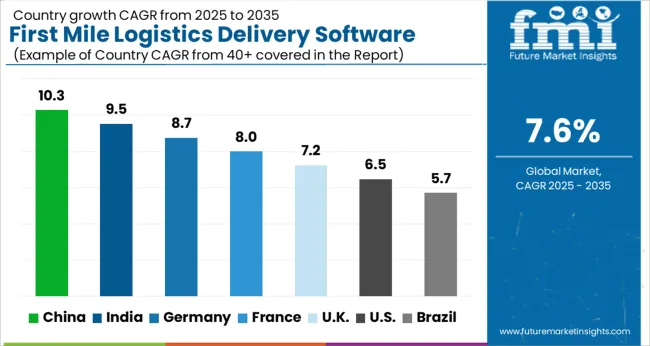
The first mile logistics delivery software industry is forecast to expand at a global CAGR of 7.6% between 2025 and 2035, driven by the rapid adoption of digital platforms, predictive analytics, and automation in supplier-to-warehouse operations. China leads with a CAGR of 10.3%, supported by high-volume e-commerce flows, extensive warehousing networks, and strong investment in logistics digitization. India follows at 9.5%, benefiting from expanding retail distribution, rising demand for supply chain visibility, and fast-growing direct-to-consumer models. France records an 8.0% growth rate, while the United Kingdom and the United States, at 7.2% and 6.5%, respectively, concentrate on compliance-driven adoption, regional warehousing, and specialized logistics applications. These countries set critical benchmarks for software integration, automation depth, and logistics network efficiency, forming the foundation for future capacity planning and competitive differentiation across the logistics software landscape.
China is forecasted to achieve a CAGR of 10.3% for 2025-2035, higher than the approximately 9.0% observed between 2020-2024. The improvement is supported by large-scale e-commerce operations, widespread logistics digitization, and AI-driven dispatch adoption. Expanding warehousing clusters across key provinces and the integration of supplier-to-warehouse platforms have strengthened operational efficiency. Competitive delivery costs and the ability to integrate software with enterprise systems keep China in a leadership position within global logistics software. Regional distribution networks have benefited from high-volume adoption, while strong government support for digital trade further accelerates growth. China continues to be the prime benchmark for capacity planning and digital logistics transformation.
India is projected to record a CAGR of 9.5% for 2025-2035, higher than the approximately 8.2% achieved between 2020-2024. The acceleration is influenced by rapid retail expansion, stronger direct-to-consumer distribution, and rising demand for upstream delivery visibility. Regional distribution is being enhanced by investments in digital freight corridors, making first mile platforms essential in fragmented logistics systems. Adoption of mobile-enabled tools has improved supplier coordination and reduced restocking inefficiencies. India’s cost advantage, combined with its rapidly growing e-commerce base, has facilitated the broader adoption of logistics platforms across both urban and regional trade hubs. The momentum places India as a leading market for scalable software integration.

France is expected to record a CAGR of 8.0% between 2025-2035, above the 7.1% achieved during 2020-2024. The improvement is driven by adoption of first mile software across automotive, pharmaceuticals, and consumer goods. Emphasis on compliance and traceability has strengthened software usage as companies prioritize accuracy in supply movements. Growth in warehouse clustering and regional distribution hubs has further supported integration of digital platforms. Companies in France have increased reliance on predictive and automation tools to improve resource utilization and ensure reliable deliveries. The role of compliance-driven logistics requirements is expected to keep France on an upward trajectory.
The United Kingdom is forecasted to achieve a CAGR of 7.2% for 2025-2035, higher than the approximate 6.1% observed during 2020-2024. This growth is influenced by restructuring in retail logistics, increased demand for quick commerce, and integration of predictive tools in supplier pickups. Greater adoption of cloud-based solutions for real-time coordination has reduced lead times significantly. The acceleration from 2020-2024 to 2025-2035 highlights a stronger reliance on digital-first logistics strategies. With omni-channel retail gaining prominence and regional warehouses being established, the UK market has transitioned toward a more software-driven model that supports flexible and efficient first mile operations.
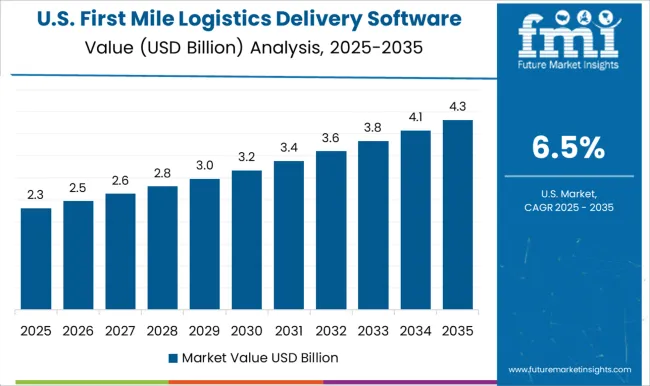
The United States is projected to post a CAGR of 6.5% for 2025-2035, slightly above the 5.8% achieved during 2020-2024. Growth is driven by specialized logistics sectors such as pharmaceuticals, high-value electronics, and food retail. Compliance and traceability requirements have encouraged greater adoption of delivery software. Expansion of cold-chain logistics has increased reliance on digital platforms to maintain shipment integrity from supplier to warehouse. Investments in warehouse automation and real-time dispatch platforms have enhanced efficiency across regional distribution networks. The role of software has become increasingly critical in managing supplier coordination and achieving accuracy in delivery cycles across a highly regulated logistics environment.

The first mile logistics delivery software market is influenced by global technology providers and specialized supply chain solution companies offering digital platforms for supplier-to-warehouse coordination, predictive dispatch, and visibility enhancement. Prominent players include Oracle Corporation and SAP SE, both known for enterprise-grade logistics integration and scalable digital platforms that connect seamlessly with ERP systems. Trimble Transportation and E2open have focused on predictive supply chain analytics, real-time tracking, and transportation management solutions, helping companies streamline supplier operations. Epicor Software Corporation and Blue Yonder bring strong capabilities in warehouse management, resource planning, and automation-driven logistics execution.
Descartes Systems Group and Kinaxis are recognized for advanced supply chain orchestration, offering cloud-based planning tools that improve agility across industries. ShipBob and Shipsy represent fast-growing solution providers catering to e-commerce, last mile, and cross-border trade segments, where first mile optimization has become critical. These companies differentiate themselves through cloud deployment models, integration with ERP and TMS platforms, and AI-driven dispatch optimization. Strategic growth initiatives include expansion into quick commerce logistics, regional warehousing integration, and partnerships with third-party logistics providers. Competitive positioning is reinforced by strong investment in predictive software, mobile-enabled tools, and compliance-driven solutions that support traceability and accuracy. The market focus is shifting toward enhancing delivery reliability, reducing operational costs, and securing a larger role in digital supply chain transformation across multiple industries.
| Item | Value |
|---|---|
| Quantitative Units | USD 4.4 Billion |
| Component | Software and Service |
| Application | Route planning and optimization, Inventory management, Order management, Shipment tracking, and Others |
| Deployment Type | Cloud-based and On-premises |
| Organization Size | Large enterprises and Small and medium enterprises (SME) |
| End-User Industry | Retail and E-Commerce, Manufacturing, Healthcare, Automotive, Food and beverage, Energy and utilities, Aerospace and defense, and Others |
| Regions Covered | North America, Europe, Asia-Pacific, Latin America, Middle East & Africa |
| Country Covered | United States, Canada, Germany, France, United Kingdom, China, Japan, India, Brazil, South Africa |
| Key Companies Profiled | Oracle Corporation, SAP SE, Trimble Transportation, E2open, Epicor Software Corporation, Blue Yonder, Descartes Systems Group, Kinaxis, ShipBob, and Shipsy |
| Additional Attributes | Dollar sales, share, competitive positioning, adoption by e-commerce and 3PLs, regional growth hotspots, integration trends with ERP/TMS, and customer adoption drivers. |
The global first mile logistics delivery software market is estimated to be valued at USD 4.4 billion in 2025.
The market size for the first mile logistics delivery software market is projected to reach USD 9.2 billion by 2035.
The first mile logistics delivery software market is expected to grow at a 7.6% CAGR between 2025 and 2035.
The key product types in first mile logistics delivery software market are software and service.
In terms of application, route planning and optimization segment to command 34.8% share in the first mile logistics delivery software market in 2025.






Our Research Products

The "Full Research Suite" delivers actionable market intel, deep dives on markets or technologies, so clients act faster, cut risk, and unlock growth.

The Leaderboard benchmarks and ranks top vendors, classifying them as Established Leaders, Leading Challengers, or Disruptors & Challengers.

Locates where complements amplify value and substitutes erode it, forecasting net impact by horizon

We deliver granular, decision-grade intel: market sizing, 5-year forecasts, pricing, adoption, usage, revenue, and operational KPIs—plus competitor tracking, regulation, and value chains—across 60 countries broadly.

Spot the shifts before they hit your P&L. We track inflection points, adoption curves, pricing moves, and ecosystem plays to show where demand is heading, why it is changing, and what to do next across high-growth markets and disruptive tech

Real-time reads of user behavior. We track shifting priorities, perceptions of today’s and next-gen services, and provider experience, then pace how fast tech moves from trial to adoption, blending buyer, consumer, and channel inputs with social signals (#WhySwitch, #UX).

Partner with our analyst team to build a custom report designed around your business priorities. From analysing market trends to assessing competitors or crafting bespoke datasets, we tailor insights to your needs.
Supplier Intelligence
Discovery & Profiling
Capacity & Footprint
Performance & Risk
Compliance & Governance
Commercial Readiness
Who Supplies Whom
Scorecards & Shortlists
Playbooks & Docs
Category Intelligence
Definition & Scope
Demand & Use Cases
Cost Drivers
Market Structure
Supply Chain Map
Trade & Policy
Operating Norms
Deliverables
Buyer Intelligence
Account Basics
Spend & Scope
Procurement Model
Vendor Requirements
Terms & Policies
Entry Strategy
Pain Points & Triggers
Outputs
Pricing Analysis
Benchmarks
Trends
Should-Cost
Indexation
Landed Cost
Commercial Terms
Deliverables
Brand Analysis
Positioning & Value Prop
Share & Presence
Customer Evidence
Go-to-Market
Digital & Reputation
Compliance & Trust
KPIs & Gaps
Outputs
Full Research Suite comprises of:
Market outlook & trends analysis
Interviews & case studies
Strategic recommendations
Vendor profiles & capabilities analysis
5-year forecasts
8 regions and 60+ country-level data splits
Market segment data splits
12 months of continuous data updates
DELIVERED AS:
PDF EXCEL ONLINE
First Mile Delivery Market Size and Share Forecast Outlook 2025 to 2035
Last Mile Delivery Software Market Analysis - Size, Share, and Forecast Outlook 2025 to 2035
Last-mile Delivery Software Market in Korea – Trends & Forecast through 2035
Western Europe Last-mile Delivery Software Market – Growth & Outlook through 2035
Industry Analysis of Last-mile Delivery Software in Japan Size and Share Forecast Outlook 2025 to 2035
Last Mile Delivery Market Size and Share Forecast Outlook 2025 to 2035
Middle Mile Delivery Market Size and Share Forecast Outlook 2025 to 2035
Delivery Management Software Market Size and Share Forecast Outlook 2025 to 2035
Logistics Visibility Software Market Size and Share Forecast Outlook 2025 to 2035
Electric Last Mile Delivery Vehicle Market Analysis - Size, Share, and Forecast Outlook 2025 to 2035
Automotive Logistics Management Software Market Size and Share Forecast Outlook 2025 to 2035
Q-Commerce Last-Mile Thermal Packs & Reverse Logistics Market Analysis - Size, Share, and Forecast Outlook 2025 to 2035
Software-Defined Wide Area Network Market Size and Share Forecast Outlook 2025 to 2035
Logistics Packaging Market Size and Share Forecast Outlook 2025 to 2035
Software Defined Vehicle Market Size and Share Forecast Outlook 2025 to 2035
Software Defined Networking (SDN) And Network Function Virtualization (NFV) Market Size and Share Forecast Outlook 2025 to 2035
Software Defined Perimeter (SDP) Market Size and Share Forecast Outlook 2025 to 2035
Software-Defined Wide Area Network SD-WAN Market Size and Share Forecast Outlook 2025 to 2035
Logistics Robots Market Size and Share Forecast Outlook 2025 to 2035
Software Defined Radio (SDR) Market Size and Share Forecast Outlook 2025 to 2035

Thank you!
You will receive an email from our Business Development Manager. Please be sure to check your SPAM/JUNK folder too.
Chat With
MaRIA